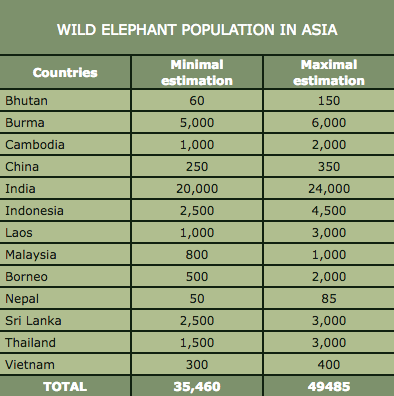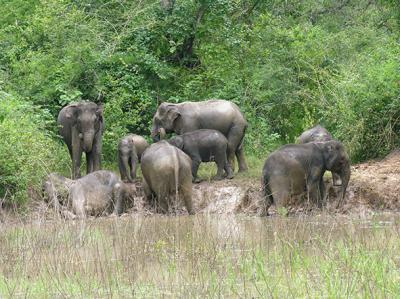


The Elephant Nation

by Prajna Chowta
in "News from India" cultural magazine of the Embassy of India, Paris, 2003
It is impossible to imagine India without elephants, as long as this fascinating animal species captivates the popular imagination. Nevertheless, the artificial presence of elephants in prominent tourist places like Jaipur in Rajasthan, Guruvayur in Kerala or Bihar's shrouded jewels, Sonepur, mask the precarious situation of this endangered species in general. In fact, recent research indicates that there are all in all 45,000 elephants in entire Asia and specialists doubt if the species will survive in the coming centuries.
Since the 70's, the attention has been focused on the African elephant that continues to subsist even after a severe blow of systematic poaching used to nourish the ivory market. Today, there remain around 400,000 specimens. The trade in ivory has been banned by the CITES* and the attention of the public has evolved. The interdiction has altogether been beneficial for the species, but for the perverse effect of augmenting vertiginously the price of ivory in the clandestine market.
Recently, there were erroneous rumours about a supposed increase in the population of elephants in Africa, propagated by contingents interested in the ivory trade, to mollify the human conscience. The pressures exerted by countries consuming ivory, with Japan an China at its head, are calling into question the international conventions. Presently, three countries in South Africa have been reauthorized to export ivory. Poaching has revived practically everywhere, including in Asia, refloating wild animal products in the illegal market, which in global importance is only second to drugs.
The Asian elephant is the poor, forgotten cousin. Never has it dominated the international attention. Never has it benefited from the same efforts of conservation. It is a species apart, genetically apart from the African elephant. The Asian elephants is in grave danger of extinction. The population that survives in the wild at present is divided into thirteen countries of the South and Southeast Asia and the number of wild individuals is situated between 35,000 and 45,000, the largest portions are found in India and then Burma (Myanmar). Add to it something like 16,000 "domestic" elephants in Asia. The Asian elephant is actually classified amongst the most endangered species in the world.

The unique relationship between man and elephant in Asia goes back more than 5000 years, when elephants started being captured and trained as draught animals, for wars, parades and religious ceremonies. No other animal has known this relation with man as still being effectively a wild species because the breeding of elephants in captivity had no real success.
Ancient Hindu texts make a numerous references to elephants, and Ganesha, the god with a head of an elephant, is revered throughout India. The white elephant has a particular significance for Buddhists all over Asia. In Chinese culture, the elephant played a particular role along the centuries in its folklore, in games, pageantry and medicine.
Historically, the Asian elephant was very important from an economical point of view, notably in forest operations, a practise that was developed on a grand scale during the British period. The Bombay Burma Trading Corporation employed up to 4,000 elephants for extraction of teak in Burma alone before World War II. The extraction of timber with the help of elephants has cost a high price to the species, and still recently, it was advocated as a method with the least impact on the forest during selective extraction, compared to modern machinery. But the final reasoning came in 1994, when the Supreme Court of India banned the exraction of timber in the entire country. The fragments from the immense habitat of Asian elephant have at present a chance to be preserved in India, which is not the case in Burma, where this practise is pursued at an unleashed rhythm.

Nowadays, biologists have realised that the elephant appears to be the keystone in the ecology of the forest it occupies. Its size and its social behaviour helps the elephant cover long distances and acclimatize to a variety of habitats that offer a refuge to a multitude of other species. Multiple vegetal species can only flourish in effect to their genus pattern; certain can only reproduce if passed once through the digestive system of an elephant, the hard endocarp of the seed splits and germinates in the fresh dung. So, the elephant population prosperity is an infallible barometer to the prosperity of other animal, vegetal species, the forests, flowing water, and the complete balance to the ecosystem that they are a part of.
The recent decline in the African elephant population is due to the poaching of its ivory on a grand scale, while the Asian elephant is subject to other threats very difficult to overcome. They live in regions amongst the most populated in the world. The growth in the human population and the pressures on their natural habitat for the development of agriculture and other human activities are the causes for the dramatic loss of forest areas. As a consequence, elephants and humans are in direct competition for the same natural resources. As a result of the degradation of the forest, the population of Asian elephants is highly fragmented which increases the risk of extinction by geographic zone.
Ivory poaching also occurs in Asia, targetting only the males as females do not have tusks. The Asian ivory is mixed with the stocks of African ivory, and the two are very difficult to distinguish. The dramatic consequences of poaching in Asia is the imbalance of the sex ratio. In some reserves, the ratio is of 1 male to 100 females with a direct impact on reproduction.
The destiny of the elephants stirs up at the same time passion and despair. For those who search to understand the situation, a map of South Asia with blurred political frontiers leaves place to what we can call "The Elephant Nation".
Just a couple of centuries ago, elephants could roam freely in a continuous wild territory stretching from Vietnam, passing through the foothills of the Himalayas unto the south of India. The increasing occupation of their natural habitat by human beings has fragmented the elephant's ancient migratory routes, and as of now, the largest wild populations are located partly in Assam, partly in the South India. Smaller populations are still found in South-East Asia and Sri Lanka.
The conservation of wild species is a serious subject of preoccupation in India, where excellent biologists and zoologists are at work and a solid legislation exists. In spite of an immense human population, our country shelters the largest population of elephants and tigers. However, progress is necessary both in the field and through public information."

* CITES: Convention on International Trade in Endangered Species of Wild Fauna and Flora - based in Switzerland and signed by 162 countries.
© Copyright 2008-2025 Aane Mane Foundation.
All rights reserved. Web design by Lor.